
This activity addresses Boyle's Law from a physiological perspective.
- Subject:
- Physical Science
- Material Type:
- Activity/Lab
- Provider:
- Concord Consortium
- Provider Set:
- Concord Consortium
- Author:
- Concord Consortium
- Date Added:
- 05/14/2021

This activity addresses Boyle's Law from a physiological perspective.

This activity uses the phenomena of hydrogen-filled weather balloons and hot air balloons to explore some of the gas laws.
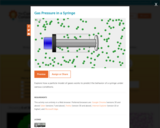
Explore how a particle model of gases works to predict the behavior of a syringe under various conditions.
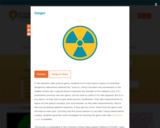
In this dynamic data science game, students try to track down a speck of extremely dangerous radioactive material (the "source"), which has been lost somewhere in the middle of their lab. A special device measures the strength of the radiation and, if it's positioned correctly over the speck, can be used to collect it for safe disposal. But it's a tiny speck, so they have to give quite precise coordinates. They take measurements to figure out the speck's location, but must beware: as they take measurements, they're also accumulating radiation exposure. If they get too much, they'll lose the game and will have to start over. Can they find the source before it's too late? Using mathematical models, students generate useful strategies for winning the game with data.
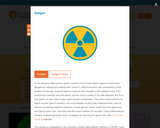
In this dynamic data science game, students try to track down a speck of extremely dangerous radioactive material (the "source"), which has been lost somewhere in the middle of their lab. A special device measures the strength of the radiation and, if it’s positioned correctly over the speck, can be used to collect it for safe disposal. But it's a tiny speck, so they have to give quite precise coordinates. They take measurements to figure out the speck’s location, but must beware: as they take measurements, they're also accumulating radiation exposure. If they get too much, they’ll lose the game and will have to start over. Can they find the source before it’s too late? Using mathematical models, students generate useful strategies for winning the game with data.

The Geniverse software is being developed as part of a five-year research project funded by the National Science Foundation. Still in its early stages, a Beta version of the software is currently being piloted in six schools throughout New England. We invite you to try the current Beta version, keeping in mind that you may encounter errors or pages that are not fully functional. If you encounter any problem, it may help to refresh or reload the web page.

How might Earth's temperature change in the future? Use this model to explore how changing human emissions of greenhouse gases might affect the temperature. The model incorporates positive and negative feedback loops. Ice cover and cloud cover change in response to the level of water vapor and temperature in the model.
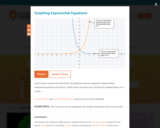
Learn about exponential functions by graphing various equations representing exponential growth and decay. Graph these functions by connecting ordered pairs on x-y axes.
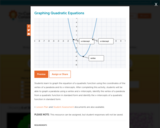
Students learn to graph the equation of a quadratic function using the coordinates of the vertex of a parabola and its x-intercepts. After completing this activity, students will be able to graph a parabola using a vertex and x-intercepts, identify the vertex of a parabola from a quadratic function in standard form and identify the x-intercepts of a quadratic function in standard form.

Build your own miniature "greenhouse" out of a plastic container and plastic wrap, and fill it with different things such as dirt and sand to observe the effect this has on temperature. Monitor the temperature using temperature probes and digitally plot the data on the graphs provided in the activity.

Explore how the Earth's atmosphere affects the energy balance between incoming and outgoing radiation. Using an interactive model, adjust realistic parameters such as how many clouds are present or how much carbon dioxide is in the air, and watch how these factors affect the global temperature.
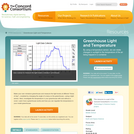
Make your own miniature greenhouse and measure the light levels at different "times of day"--modeled by changing the angle of a lamp on the greenhouse--using a light sensor. Next, investigate the temperature in your greenhouse with and without a cover. Learn how a greenhouse works and how you can regulate the temperature in your model greenhouse.

This model shows how the size of an object affects how much heat energy it holds and hence how much is needed to heat it up or cool it down. You can explore this by watching the heat transfer between two objects with different sizes and different temperatures.
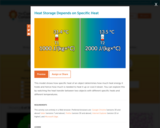
This model shows how specific heat of an object determines how much heat energy it holds and hence how much is needed to heat it up or cool it down. You can explore this by watching the heat transfer between two objects with different specific heats and different temperatures.

Discover how electricity can be converted into other forms of energy such as light and heat. Connect resistors and holiday light bulbs to simple circuits and monitor the temperature over time. Investigate the differences in temperature between the circuit with the resistor and the circuit using the bulb.
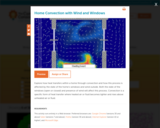
Explore how heat transfers within a home through convection and how this process is affected by the state of the home's windows and wind outside. Both the state of the windows (open or closed) and presence of wind will affect this process. Convection is a specific form of heat transfer where heated air or fluid becomes lighter and rises above unheated air or fluid.

Learn how the code on a strand of DNA can be used to make a protein.

Being able to control the movement of electrons is fundamental for making all electronic devices work. Discover how electric and magnetic fields can be used to move electrons around. Begin by exploring the relationship between electric forces and charges with vectors. Then, learn about electron fields. Finally, test your knowledge in a fun "Electron Shooting" game!

Use the Sound Grapher to create visualizations of sound and learn about the frequency, wavelength, amplitude and velocity of sound waves.

In this investigation, students will learn how non-polar interactions in combination with polar interactions they learned about in the previous unit effect shape of biological molecules and their function. This investigation builds towards PE HS-PS3-5 and PE HS-LS1-6.